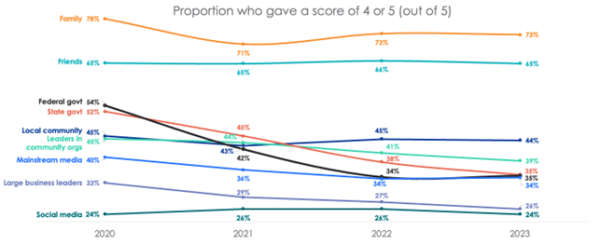Many Australians increasingly feeling divided
More than two fifths of Australians feel the country is more divided than a year ago, according to the 2023 Togetherness Index.
The debate surrounding the Voice has compounded a sense of division which has grown amid the cost-of-living crisis and in the wake of the COVID-19 pandemic.
An overwhelming majority (75 per cent) either think, or is unsure if, Australia is divided, the research from SenateSHJ reveals.
Just a quarter of Australians think the country is united. For this minority, the Matildas’ World Cup success and our community spirit are key factors in bringing the country together.
Darren Behar, Managing Partner at SenateSHJ, said: “The cost-of-living crisis has driven feelings of division. There is a sense of the haves and have nots, and that people are less likely to look out for each other. This has compounded feelings of division brought on by COVID-19.
“Unfortunately, the way in which the debate around the referendum is unfolding is leaving many feeling like there is little room for open discussion.”
Those who feel that we are more divided overall have lower scores on the Togetherness Index with the biggest driver being that people do not feel listened to.
Since 2020, the Togetherness Index has explored what components of communication contribute to togetherness or social cohesion within the community. It considers communication from sources as diverse as government, media, social media, family, friends and community organisations.
The research reveals that trust in communication from government, media and large businesses continues to decline.
Instead, trusted sources of information come from more hyper local sources. We continue to turn to those close to us for connection, optimism and information. While just a third of people trust government and media sources, three quarters trust their family and two thirds their friends and neighbours.
Jodie Wrigley, Head of Social Change at SenateSHJ, said: “The Togetherness Index helps guide how we reach people, how we communicate to enhance trust and togetherness. There is an opportunity at every level of society from individuals to government, to bring communities together.
With only 29 per cent of us feeling listened to, there is opportunity for us as individuals, communities, organisations and governments to make a difference. Taking the time to listen to other people’s experiences, stories and points of view can help create stronger connections and makes others feel heard and valued.”
About the Togetherness Index:
The Togetherness Index (TI) explores the role communication plays in connecting people. It looks at what communication elements contribute to togetherness or social cohesion within the community. While there are many factors including wellbeing, health, economic opportunity and performance that contribute to overall social cohesion, the TI takes a unique perspective. It reviews communication from sources as diverse as government, media, social media, family, friends and community organisations.
The TI identifies five communication drivers that rate highly in those who have the strongest sense of togetherness. They are:
- Closeness: how close we are to different groups
- Listening: whether we feel listened to by people and institutions
- Optimism: how people feel after seeing, hearing or reading a message
- Stories: how exposed we are to stories from people with different backgrounds
- Effectiveness: how effective the communication we see, hear and read, is.
We’ve measured these five elements over time and derived an index score for each. The overall combined average makes up the Togetherness Index.
A score of 100 means an ideal situation in which we are effectively using communication to drive social cohesion. The index shows the results for each of the five drivers and a total index based on the average of the five.
The TI is conducted online, with a sample size of 1,500 people aged 18+, sourced from ISO accredited research panel Dynata. Data is weighted to match the latest Census population statistics for gender, age, state and location, and resembles the Australian population based on these criteria. Fourteen demographic variables are also collected, including religion, country of birth, household income, education, employment status and NESB background.
2023 top line results
Togetherness Index

Is Australia united or divided?
- In your opinion, do you believe people in Australia are currently…?

- Do you think the people in Australia are more united or divided than 12 months ago?

Trust in information
- Using the scale where 1 means ‘do not trust at all’ and up to 5 meaning ‘completely trustworthy’, to what extent do you trust information communicated by the following people about issues of relevance to you and your community.
